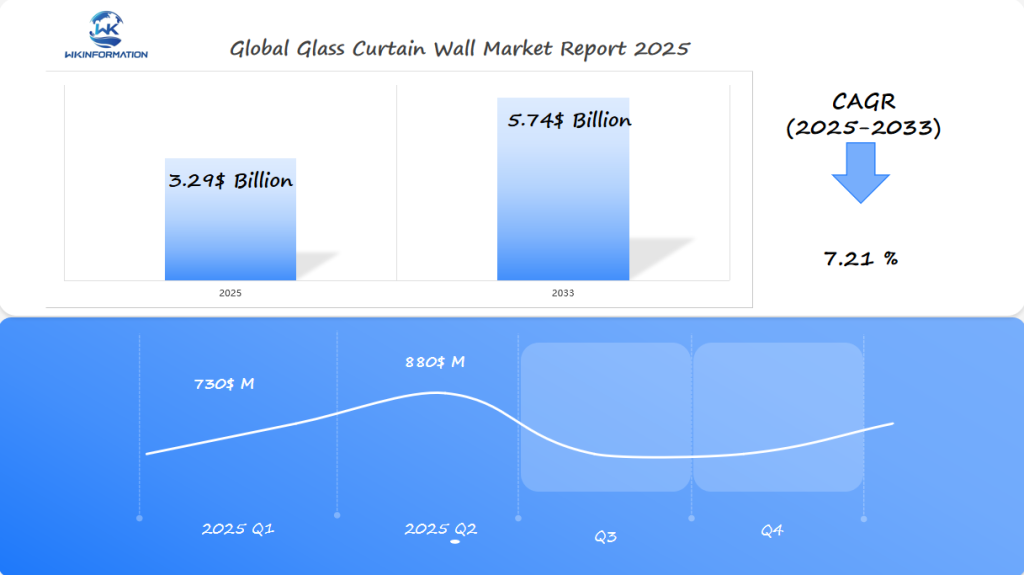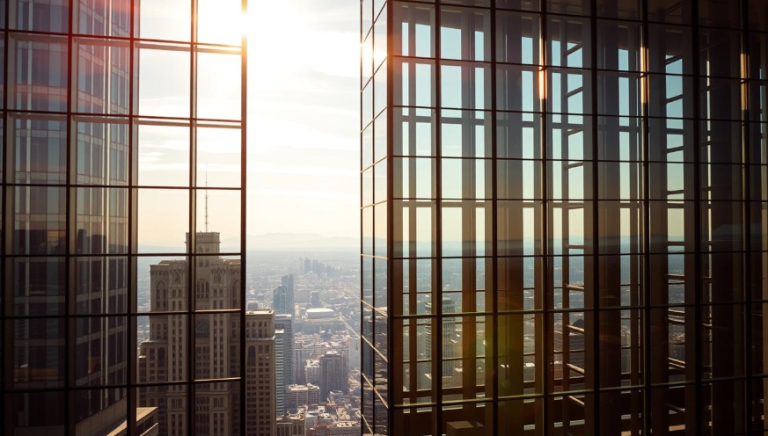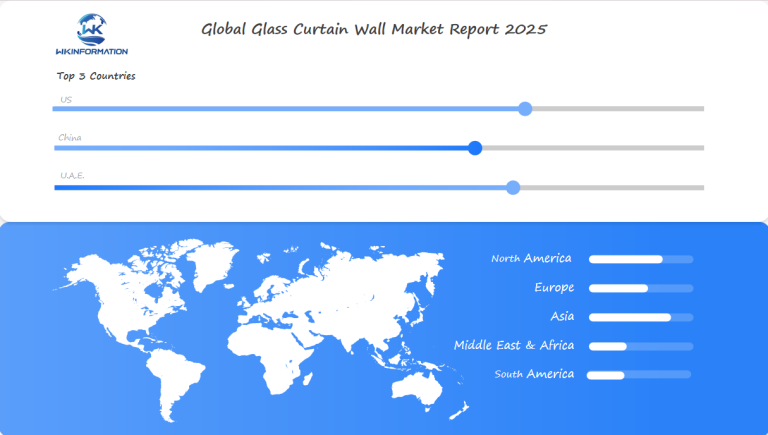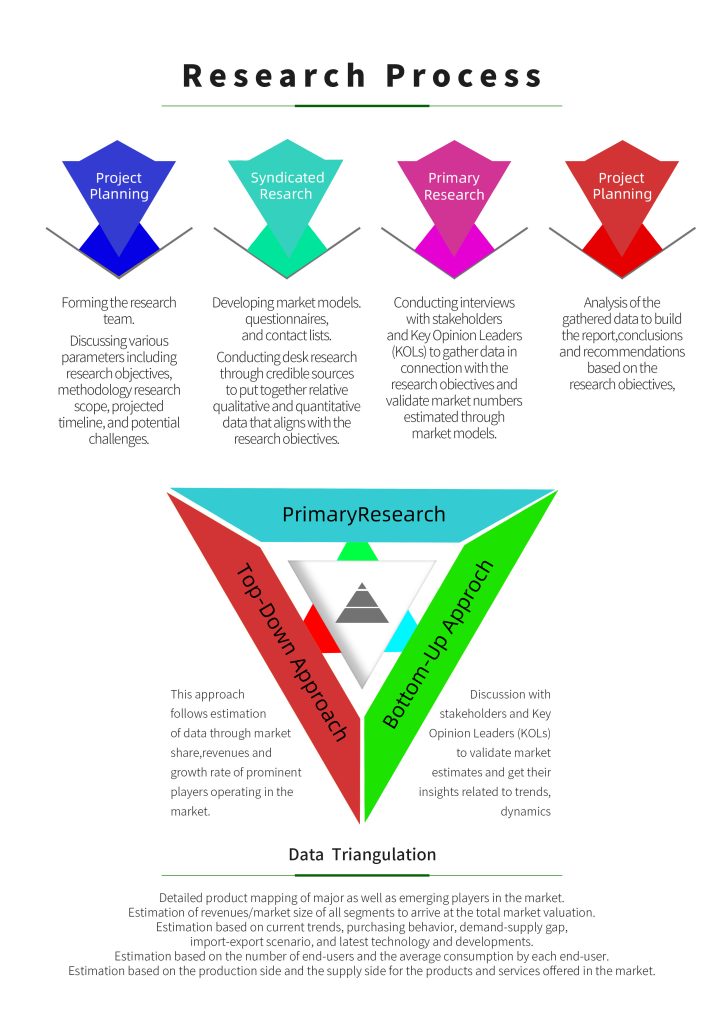Glass Curtain Wall Market Projected at $3.29 Billion by 2025: Architectural Trends in the U.S., China, and the U.A.E.
Explore the expanding Glass Curtain Wall Market as modern architecture drives demand. Discover market trends, technological innovations, and growth prospects in construction sectors globally.
- Last Updated:
Glass Curtain Wall Market Q1 and Q2 2025 Outlook
The Glass Curtain Wall market is projected to reach $3.29 billion in 2025, with a strong CAGR of 7.21% expected through 2033. Market data for Q1 2025 is estimated at approximately $730 million, reflecting a moderate start influenced by seasonal demand and construction schedules. In Q2 2025, the market is anticipated to grow significantly to around $880 million, driven by increased construction activity and heightened infrastructure investments worldwide.

Key Takeaways
- The market is projected to reach $3.29 billion by 2025.
- There are significant technological innovations in glass curtain wall systems.
- There is a growing emphasis on energy-efficient architectural solutions.
- The U.S. and Chinese construction markets are experiencing increased adoption.
- There is a rising demand for sustainable building envelope technologies.
Upstream and Downstream Industry Chain Analysis of the Glass Curtain Wall Market
The glass curtain wall market involves various components in its upstream and downstream industry chain. Here is an analysis of these segments:
Upstream Analysis:
- Raw Materials Suppliers: Companies that provide materials like glass, aluminum, steel, and insulation products for curtain wall manufacturing.
- Technology Providers: Innovators developing advanced coatings, smart glass technologies, and photovoltaic systems for energy-efficient curtain walls.
- Equipment Manufacturers: Suppliers of machinery and tools used in the production and installation of glass curtain walls.
Downstream Analysis:
- Architectural Design Firms: Entities designing buildings that incorporate glass curtain walls based on client requirements and industry trends.
- Construction Contractors: Companies responsible for installing glass curtain walls as part of building projects.
- Real Estate Developers: Entities investing in properties featuring modern glass curtain wall designs to attract tenants or buyers.
Understanding these upstream and downstream elements is crucial for stakeholders in the glass curtain wall market to effectively navigate industry dynamics and capitalize on emerging opportunities.
Trends in sustainable building designs and energy efficiency
The glass curtain wall market is changing fast. Architects and developers are now focusing on energy efficiency and green architecture. These are key parts of modern building design.
There are new trends in sustainable building that are changing the industry:
- Advanced thermal insulation materials that reduce heat transfer
- Smart glass technologies with dynamic light-filtering capabilities
- Photovoltaic integrated glass systems generating renewable energy
- High-performance coatings that improve overall building energy efficiency
Now, sustainable building strategies aim to reduce environmental impact while improving performance. Innovative glass curtain wall designs help buildings get green certifications like LEED and BREEAM.
Top manufacturers are making glass curtain wall systems with better thermal performance. These systems use advanced technologies to control natural light, reduce solar heat, and boost energy efficiency.
- Reduced carbon footprint through sustainable materials
- Enhanced thermal regulation
- Improved occupant comfort and productivity
The mix of green architecture and advanced glass technologies is a big step forward. Architects can now design buildings that are both beautiful and good for the environment.
Market restrictions due to building codes and material costs
The glass curtain wall market is facing big challenges. These include complex building codes and changing material costs. Manufacturers and architects must find a balance between new designs and strict rules. This balance affects if a project can happen and if it’s affordable.
Some major challenges in the glass curtain wall industry are:
- Strict building codes that limit what materials can be used
- Prices of raw materials that keep changing
- Rules for how well buildings must save energy
- Rules for how strong and safe buildings must be
Following all the rules costs a lot of money. Material costs can really affect how much a project will cost. Builders need smart ways to deal with these financial issues.
Manufacturers are tackling these challenges by:
- Creating new, better materials
- Finding ways to make things cheaper
- Designing things that can be changed easily
- Working on making their manufacturing more green
The mix of building codes and new materials is changing the glass curtain wall market. It’s pushing for better technology and smart money plans for future buildings.

Geopolitical influences on construction and infrastructure projects
The global construction industry faces many challenges. These come from geopolitical factors that change how projects are done around the world. International relations and economic policies play big roles in how countries build big projects.
Key geopolitical influences affecting the construction industry include:
- Trade agreements and tariffs impacting material sourcing
- Economic sanctions restricting international collaboration
- Political stability determining infrastructure investment
- Regional conflict zones limiting construction opportunities
Companies making glass curtain wall systems have to deal with these complex issues. Being able to adapt quickly is key to staying ahead. Each area has its own set of challenges for building projects, needing special plans for design and setup.
Recent events show how politics can change building plans. Places with stable governments get more money for big projects. But areas with economic troubles see fewer building projects.
New markets are very sensitive to changes in politics. Companies making glass curtain walls need to watch global politics closely. This helps them guess when to grow or slow down in the market.
Segmentation by Type: Stick-Built, Unitized, and Structural Glazing Systems
The glass curtain wall market has three main types. Architects and builders use these in modern building designs. Each system has its own features for different architectural needs and project limits.
1. Stick-Built Curtain Walls
Stick-built curtain walls are the traditional choice. They are built piece by piece on the site. This method is great for complex designs because it allows for customization.
- Fabricated on-site
- Highly customizable
- Labor-intensive installation
- Suitable for complex architectural designs
2. Unitized Curtain Walls
Unitized curtain walls are more efficient. They are made in factories for better precision and quicker setup. This method cuts down on-site construction time.
3. Structural Glazing Systems
Structural glazing systems are the latest in curtain wall tech. They create smooth glass walls with little to no visible frames. They look great and also keep buildings warm and weatherproof.
| Curtain Wall Type | Installation Method | Key Advantages |
| Stick-Built | On-site assembly | Maximum design flexibility |
| Unitized | Factory pre-assembly | Faster installation |
| Structural Glazing | Minimal framing | Seamless aesthetic |
Architects and developers pick these systems based on the project, budget, and performance needs. The choice affects the building’s look, energy use, and upkeep costs.
Segmentation by Application: Commercial Buildings, Residential Buildings, and Public Infrastructure
Glass curtain wall systems have changed how buildings are designed. They bring unique benefits to commercial, residential, and public projects.
Benefits for Commercial Buildings
In commercial buildings, these systems add beauty and function. They help create modern, energy-saving spaces. These spaces let in lots of natural light and look great from the outside.
- Enhance building aesthetics
- Improve energy efficiency
- Provide superior thermal insulation
- Reduce overall construction costs
Advantages for Residential Buildings
Residential buildings use glass curtain walls to improve living areas. Luxury homes and tall buildings benefit from these systems. They offer amazing views, more light, and better environmental performance.
| Building Type | Key Application Benefits | Market Growth Potential |
| Commercial Buildings | Modern design, energy efficiency | High growth potential |
| Residential Buildings | Enhanced living experience, views | Moderate to high growth |
| Public Infrastructure | Durability, aesthetic diversity | Steady market expansion |
Impact on Public Infrastructure
Public infrastructure also benefits from glass curtain walls. Government buildings, transportation hubs, and cultural spots use them. These systems help create sustainable and eye-catching designs.
As cities grow, glass curtain walls will become even more important. They will shape the look and feel of commercial, residential, and public spaces.
Global regional analysis of the Glass Curtain Wall market
The global market for glass curtain walls is changing fast. Different parts of the world have their own trends and how much of the market they hold. Each area has its own style in building, economy, and technology.
Looking at the glass curtain wall market, we see a lot of variety:
- North America is a leader in green building tech
- Asia-Pacific is growing fast with new buildings
- Europe focuses on buildings that save energy
Every continent has its own way of growing in the glass curtain wall market. In the U.S., there’s a big push for green buildings. China is building more skyscrapers. The U.A.E. is known for its bold, new buildings.
The world is seeing big differences in how glass curtain walls are used. Technological innovations and local economies are key in shaping the market. They also affect how the market will grow in the future.

The U.S. market's emphasis on green building certifications
The U.S. glass curtain wall market is changing fast because of green building certifications. LEED certification is key for sustainable building designs. It makes developers and architects use more energy-efficient solutions.
Key features of green building certifications in the U.S. market
Green building certifications in the U.S. market have key features:
- Higher energy performance standards
- Less carbon footprint for commercial buildings
- Latest thermal insulation tech
- Use of sustainable materials
Architects are now using glass curtain wall systems that meet U.S. sustainability trends. These systems offer better thermal efficiency, natural light, and lower energy use.
| Certification Type | Key Focus Areas | Impact on Curtain Wall Design |
| LEED | Energy Efficiency | High-performance glazing |
| BREEAM | Environmental Assessment | Sustainable material selection |
| Green Globes | Comprehensive Sustainability | Holistic building design |
The need for innovative glass curtain wall solutions is rising. This is due to rules and companies wanting to be green. Makers are coming up with new tech that supports green building while looking good.
China's rapid urbanization and high-rise construction
The glass curtain wall market in China has seen huge growth. This is thanks to fast urban changes. Cities are getting bigger and more modern, with new buildings that use glass walls.
These walls help buildings save energy and look good. They are key to making cities look modern and work better.
What’s making the market grow fast?
- Rapid expansion of urban centers
- Increasing demand for sustainable building solutions
- Government support for innovative architectural designs
- Rising investment in high-rise construction projects
The glass curtain wall market in China is growing fast. New tech is making buildings better and more energy-saving. Chinese companies are making new glass wall solutions that look great and work well.
High-rise construction is driving the demand for glass walls. Cities like Shanghai, Beijing, and Shenzhen are showing off new buildings. These buildings use advanced glass walls, showing China’s push for modern cities.
The U.A.E.'s iconic architectural developments
The United Arab Emirates has transformed its skyline with stunning glass designs. Cities like Dubai and Abu Dhabi showcase incredible U.A.E. architecture, blending cutting-edge technology with imaginative building concepts.
Iconic buildings in the region demonstrate remarkable architectural achievements. The U.A.E. architectural revolution has produced structures that surpass traditional design boundaries:
- Burj Khalifa: The tallest freestanding structure in the world
- Burj Al Arab: A distinctive building with a sail-shaped design
- Etihad Towers: A complex of interconnected skyscrapers
Importance of Glass Curtain Wall Technology
The success of these extraordinary buildings can be attributed to the use of glass curtain wall technology. This innovative approach allows for expansive glass surfaces, providing both aesthetic appeal and functional benefits.
Investment in New Architectural Solutions
The market is actively investing in new architectural solutions that prioritize sustainability and efficiency. These solutions focus on:
- Energy efficiency: Implementing strategies to reduce energy consumption and promote renewable sources
- Aesthetic innovation: Exploring unique design concepts that push artistic boundaries
- Structural performance: Enhancing the strength and durability of buildings through advanced engineering techniques
Building Height Architectural Feature Burj Khalifa 829.8 m Advanced glass curtain wall system Etihad Towers 305 m Integrated sustainable design Sheikh Zayed Grand Mosque N/A Traditional design with modern materials
The U.A.E. continues to push architectural boundaries, becoming a global leader in innovative building design and glass curtain wall technologies.
Future development outlook in the Glass Curtain Wall market
The glass curtain wall market is set for big changes. These changes come from new technologies and different building designs. Experts say we will see a strong market that will change cityscapes worldwide.
Some key trends are shaping the future of glass curtain walls:
- Smart glass technologies with dynamic light and heat control
- Enhanced energy efficiency through advanced material innovations
- Integration of photovoltaic systems into curtain wall designs
- Sustainable manufacturing processes reducing carbon footprint
New technologies are changing what we can build. Companies are working hard to make glass systems that are strong yet light. They must also look good.
The market is expected to see some big changes:
- More demand for custom and flexible curtain wall solutions
- More people wanting self-cleaning and self-healing glass
- More use of digital tools for better building planning
Sustainability will be key in future glass curtain wall developments. Architects and builders will focus on both looking good and being green.
Competitor analysis focusing on innovation and sustainability
Key players in the glass curtain wall market are focusing on technological advancements to enhance energy efficiency and aesthetic appeal in modern architectural designs. They are expanding operations in rapidly urbanizing regions such as Asia-Pacific, where the construction industry is experiencing significant growth. Strategic collaborations with construction firms and investments in sustainable building materials are enabling these companies to strengthen their market presence and drive the adoption of innovative façade solutions.
Key Players:
-
Saint-Gobain (France)
-
AGC Inc. (Japan)
-
Guardian Industries (United States)
-
Pilkington (NSG Group) (Japan / United Kingdom)
-
Schüco International (Germany)
-
YKK AP (Japan)
-
Kawneer (Alcoa) (United States)
-
Permasteelisa Group (Italy)
-
W&W Glass (United States)
-
Oldcastle BuildingEnvelope (United States)
Overall
| Report Metric | Details |
|---|---|
| Report Name | Global Glass Curtain Wall Market Report |
| Base Year | 2024 |
| Segment by Type |
· Stick-Built · Unitized · Structural Glazing |
| Segment by Application |
· Commercial Buildings · Residential Buildings · Public Infrastructure |
|
Geographies Covered |
· North America (United States, Canada) · Europe (Germany, France, UK, Italy, Russia) · Asia-Pacific (China, Japan, South Korea, Taiwan) · Southeast Asia (India) · Latin America (Mexico, Brazil) |
| Forecast units | USD million in value |
| Report coverage | Revenue and volume forecast, company share, competitive landscape, growth factors and trends |
Global Glass Curtain Wall Market Report (Can Read by Free sample) – Table of Contents
Chapter 1: Glass Curtain Wall Market Analysis Overview
- Competitive Forces Analysis (Porter’s Five Forces)
- Strategic Growth Assessment (Ansoff Matrix)
- Industry Value Chain Insights
- Regional Trends and Key Market Drivers
- Glass Curtain Wall Market Segmentation Overview
Chapter 2: Competitive Landscape
- Global Glass Curtain Wall Players and Regional Insights
- Key Players and Market Share Analysis
- Sales Trends of Leading Companies
- Year-on-Year Performance Insights
- Competitive Strategies and Market Positioning
- Key Differentiators and Strategic Moves
Chapter 3: Glass Curtain Wall Market Segmentation Analysis
- Key Data and Visual Insights
- Trends, Growth Rates, and Drivers
- Segment Dynamics and Insights
- Detailed Market Analysis by Segment
Chapter 4: Regional Market Performance
- Consumer Trends by Region
- Historical Data and Growth Forecasts
- Regional Growth Factors
- Economic, Demographic, and Technological Impacts
- Challenges and Opportunities in Key Regions
- Regional Trends and Market Shifts
- Key Cities and High-Demand Areas
Chapter 5: Glass Curtain Wall Emerging and Untapped Markets
- Growth Potential in Secondary Regions
- Trends, Challenges, and Opportunities
Chapter 6: Product and Application Segmentation
- Product Types and Innovation Trends
- Application-Based Market Insights
Chapter 7: Glass Curtain Wall Consumer Insights
- Demographics and Buying Behaviors
- TargetAudience Profiles
Chapter 8: Key Findings and Recommendations
- Summary of Glass Curtain Wall Market Insights
- Actionable Recommendations for Stakeholders

Access the study in MULTIPLEFORMATS
Didn’t find what you’re looking for?
TALK TO OUR ANALYST TEAM
Need something within your budget?
NO WORRIES! WE GOT YOU COVERED!
Call us on: +1-866-739-3133
Email: infor@wkinformation.com
What is a glass curtain wall?
A glass curtain wall is a non-structural exterior building facade. It’s made of lightweight materials like glass panels and aluminum framing. It also has specialized seals. This system provides thermal insulation, weather protection, and adds beauty to modern buildings.
How do glass curtain walls contribute to energy efficiency?
Glass curtain walls improve energy efficiency with advanced technologies. These include low-emissivity coatings and thermal breaks. They also use strategic glazing to reduce heat transfer. This helps control indoor temperatures and lowers energy consumption.
What are the main types of glass curtain wall systems?
There are three main types: stick-built, unitized, and structural glazing systems. Stick-built systems are built on-site. Unitized systems are pre-fabricated. Structural glazing offers a seamless look.
What factors influence glass curtain wall design and selection?
Several factors influence design and selection. These include:
- Building location
- Climate
- Architectural needs
- Energy standards
Budget, local codes, and performance needs like wind resistance also play a role.
How do building codes impact glass curtain wall implementation?
Building codes set strict requirements for glass curtain walls. They cover structural integrity, fire resistance, thermal performance, and safety. Manufacturers and architects must follow these rules to ensure proper installation and certification.
Which regions are driving the growth of the glass curtain wall market?
The United States, China, and the United Arab Emirates are at the forefront of market growth. These regions are experiencing significant urbanization and high-rise construction activities. Additionally, they have a strong emphasis on sustainable and innovative designs.
What role do green building certifications play in glass curtain wall adoption?
Green building certifications like LEED drive innovation in glass curtain walls. They encourage developers to use energy-efficient and sustainable solutions. This reduces environmental impact.
What are the main challenges in the glass curtain wall market?
The glass curtain wall market faces several challenges, including:
- Fluctuating material costs: The prices of materials used in manufacturing glass curtain walls can vary significantly, impacting overall project costs.
- Complex installation: Installing glass curtain walls requires specialized skills and expertise, making the process more complicated and time-consuming.
- Thermal performance maintenance: Ensuring that the glass curtain walls maintain their thermal performance over time is crucial for energy efficiency.
- Building code compliance: Meeting local building codes and regulations is essential for the legality and safety of structures.
To overcome these challenges, manufacturers need to continuously innovate and find solutions that address these issues effectively.
How do geopolitical factors affect the glass curtain wall market?
Geopolitical factors such as trade policies and economic conditions have an impact on the market. They play a role in determining how materials are sourced and how supply chains operate. Additionally, these factors can also shape the strategies used by companies to expand into new markets.
What future developments are expected in glass curtain wall technologies?
Future developments in glass curtain wall technologies include advanced smart glass technologies and improved insulation materials. Photovoltaic systems and digital design techniques will also be integrated. There will be a focus on sustainable and adaptable solutions.

